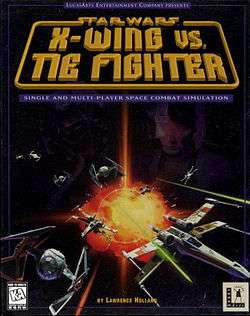Star Wars: X-Wing vs. TIE Fighter
| Star Wars: X-Wing vs. TIE Fighter | |
|---|---|
 | |
| Developer(s) | Totally Games |
| Publisher(s) | LucasArts |
| Designer(s) | Lawrence Holland |
| Platform(s) | Microsoft Windows |
| Release date(s) | 30 April 1997 |
| Genre(s) | Space simulation |
| Mode(s) | Single player, multiplayer |
Star Wars: X-Wing vs. TIE Fighter is the third installment of the X-Wing computer game series, although it is not a regular part of the series.
Including several technical advancements over the original releases of its predecessors, XvT runs on Windows, requires a joystick, features a CD audio soundtrack, supports high resolution graphics, and brings texture mapping to the ship models of the in-flight game engine. It includes robust multiplayer options for up to eight players in free-for-all, team-based, and cooperative play modes, and has a sophisticated pilot and mission selection system that tracks the player's points and awards. In addition to selecting what craft he or she will fly, the player can choose his or her squadron (and thus role in combat) for each mission.
It is the only part of the series designed almost exclusively for multiplayer and/or personal practice only, lacking a storyline. Totally Games later released an expansion called Balance of Power which added a storyline.
Expansion pack
Apart from new battles and missions, Balance of Power features a Rebel and an Imperial campaign of 15 missions each. The campaigns supported 8-player cooperative play. Both campaigns revolve around the same series of events, but with alternate endings.
- "Spreading the Rebellion" — Features the evacuation of a base, an attack against the Empire, and the capture of an Imperial Interdictor Cruiser. The campaign ends with an assault on the Super Star Destroyer Vengeance.
- "Imperial Task Force Vengeance" — The player flies as a member of the elite Avenger squadron under the leadership of Admiral Senn. The missions are similar to those from the Rebel's campaign. The campaign ends with the destruction of a Rebel factory.
The pack also adds B-wings as a pilotable craft, along with other vessels that are lacking from the original game.
Collectors edition
A cut-down limited version of X-Wing vs. TIE Fighter called Flight School was re-released as part of the X-Wing Collector Series compilation, which also contained special editions of the first two Star Wars space fighter games. In this edition, X-Wing and TIE Fighter were retrofitted with the X-Wing vs. TIE Fighter graphics engine, which uses texture mapping instead of Gouraud shading.
Development
Though it was released almost two years after TIE Fighter: Collector's CD-ROM, XvT was developed under an attenuated schedule of approximately 14 months. This was because the development team had spent several months working on a "Millennium Falcon" game that ended up being cancelled when it was recognized that the team simply didn't have the resources in time and personnel to meet the exceptionally high expectations such a title was sure to generate. Much time was devoted to creating a hybrid game engine to handle first-person "run & gun" gameplay along with the familiar flight combat, and a complex interwoven storyline featuring both a Han Solo-esque "smuggler" and a Boba Fett-inspired "bounty hunter."
XvT involved huge technical challenges to deliver a satisfactory multiplayer experience. In contrast with most popular multiplayer shooters such as Doom and Descent, XvT required far more data tracking and flow. This was due to the fact that the typical FPS takes place in a closed environment of rooms and corridors where players have little knowledge about other player's status or whereabouts unless they are literally looking right at them. The deep space setting of XvT, along with the conventions established in earlier titles, required that information about all craft be available to all players all of the time.[1]
References
External links
| ||||||